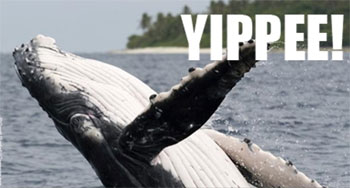Time for some rare good news! Blue whales – the largest animals in the world – are back to historic numbers and the ozone hole is closing.
When it comes to animals and plants that we share this planet with, these days we’re thrilled if the many on the verge of extinction make even a small comeback.
But in unusually great news, blue whales have reached the same population levels they were at before human interference. About 2200 blue whales live along the west coast from Mexico to Alaska, up from a mere 750 in the 1930s, when they were hunted to near extinction.

Blue whales grow to 110-feet long and weigh up to 330,000 pounds. They live in oceans around the world, but this study, published by NOAA scientists in Marine Mammal Science, focuses on the relatively small population off our west coast.
When hunting stopped, the whales recovered, and are now protected in California’s marine preserves. They still have a long way to go in other parts of the world – they are at 10-20% of historical populations in Chile and only 1% in Antarctica, where there were once 240,000 blue whales.
"They are increasing as fast as they can – about 10% a year, but at that rate their numbers will double every 10 or 11 years or so, so you can see how it will take many more decades before they get back to where they were,"
says Trevor Branch, senior author of the research and Assistant Professor of Aquatic and Fishery Sciences at University of Washington, told the Washington Post.
Why are their numbers so low in Antarctica? Because the hunting frenzy didn’t end until the early 1970s. That brings us to Japan, which is one of three nations intent on continuing whaling … in a sanctuary set aside for whale recovery – Antarctica’s Southern Ocean Whale Sanctuary. They hunt minke whales, not blue whales.
This year, the International Court of Justice – the United Nation’s top court – issued a binding decision (which means it can’t be appealed) in a landmark case, Australia v. Japan. It ordered Japan to halt its annual whale hunt in the Antarctic and to revoke all whale-taking permits. But Japan says it will go whaling this year regardless.
Ozone Layer Recovering
Demonstrating the power of international treaties, scientists have detected a statistically significant, sustained increase in stratospheric ozone, 35 years after signing the Montreal Protocol.
After sounding the alarm in the 1980s, the treaty was signed in 1987, phasing out synthetic CFCs. Unfortunately, they were replaced by HFCs, which the world is now working on phasing out.
Read our article, Montreal Protocol or Kyoto Protocol? Either Way, Phase out HFCs.
